As a bronze foundry with decades of experience crafting exquisite sculptures, we at Milystatue have always appreciated iconic bronze works that have stood the test of time. Among these, few are as captivating and meaningful as the Angel of the Waters at Bethesda Fountain in New York’s Central Park.
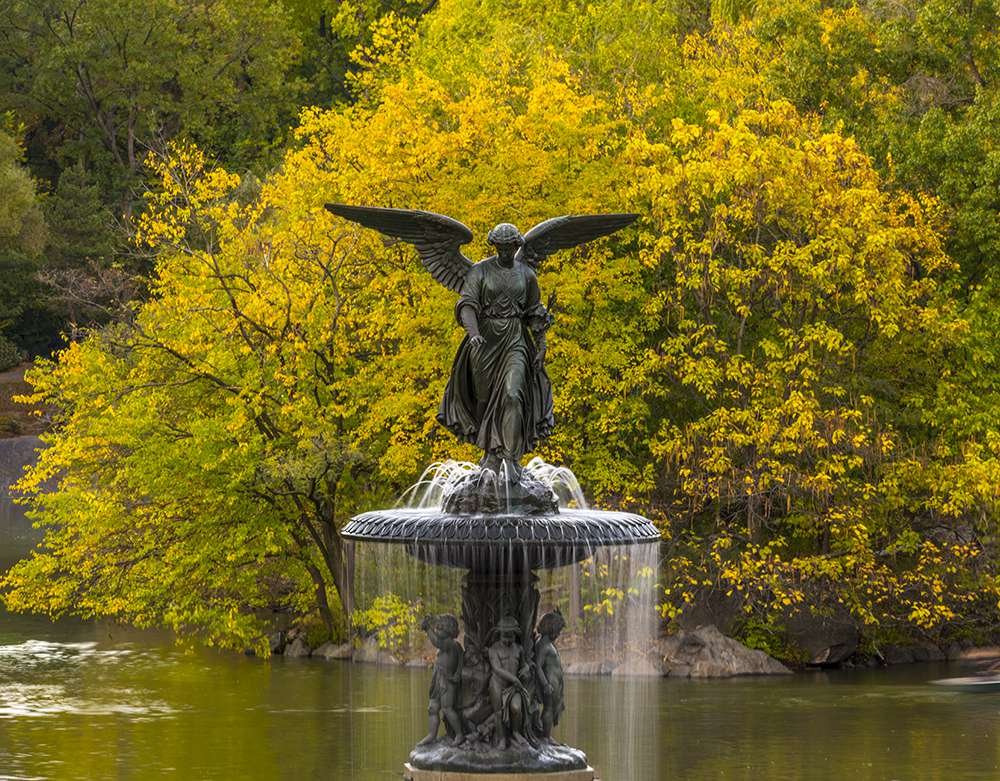
This magnificent bronze sculpture doesn’t just decorate one of America’s most beloved public spaces—it tells a story of healing, hope, and artistic achievement that continues to resonate with visitors from around the world. Today, we’d like to share the fascinating history and symbolism behind this remarkable work of art and why it remains one of the most significant bronze sculptures in American public art.
The Birth of a Masterpiece
The story of Bethesda Fountain begins in the mid-19th century, during a time when New York City was experiencing rapid growth and facing serious public health challenges. The city’s infrastructure was struggling to keep pace with its expanding population, leading to water quality issues and devastating cholera outbreaks.
In 1842, the completion of the Croton Aqueduct system marked a turning point for the city, bringing fresh, clean water to New Yorkers and helping to end the water-borne disease epidemics. This engineering achievement would later be commemorated in bronze through the Angel of the Waters.
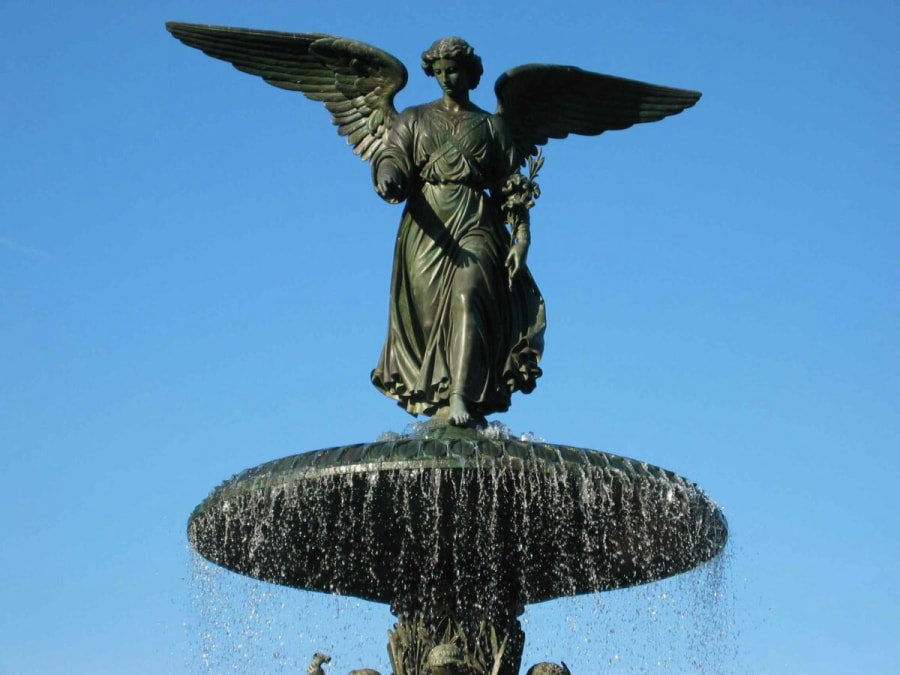
When Central Park was being designed by Frederick Law Olmsted and Calvert Vaux in the late 1850s, they envisioned an “open air hall of reception” at the heart of their urban oasis. The resulting Bethesda Terrace would become the architectural centerpiece of the park, with a grand fountain as its crowning jewel.
In 1863, sculptor Emma Stebbins received the commission to create this centerpiece—making her the first woman to receive a commission for a major public artwork in New York City. This was no small achievement in the male-dominated art world of the 19th century.
The Artist Behind the Angel
Emma Stebbins (1815-1882) was already an accomplished artist when she received the commission for what would become her most famous work. Born into a wealthy New York family, she had studied painting before moving to Rome in 1856 to pursue sculpture—a bold move for a woman of her time.
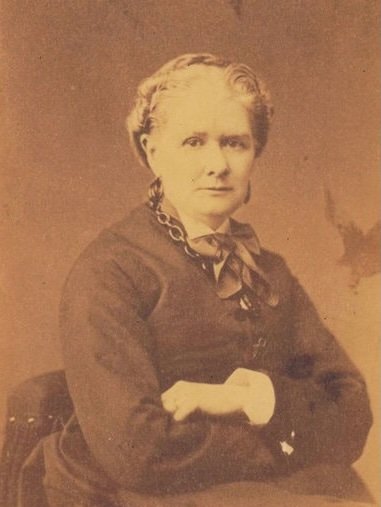
In Rome, Stebbins found herself among a community of American women artists who were defying conventional constraints of the Victorian era. She also met and fell in love with actress Charlotte Cushman, who became her lifelong companion and supporter of her artistic endeavors.
The commission for the Bethesda Fountain statue held personal significance for Stebbins, whose own brother had died from cholera—one of the water-borne diseases that had plagued New York before the Croton Aqueduct system.
Stebbins worked on the design in Rome from 1861 until its completion in 1868. The bronze statue was cast in Munich, Germany, and finally installed and dedicated in Central Park in 1873, where it has remained a beloved landmark for 150 years.
The Bronze Masterpiece: Technical Excellence
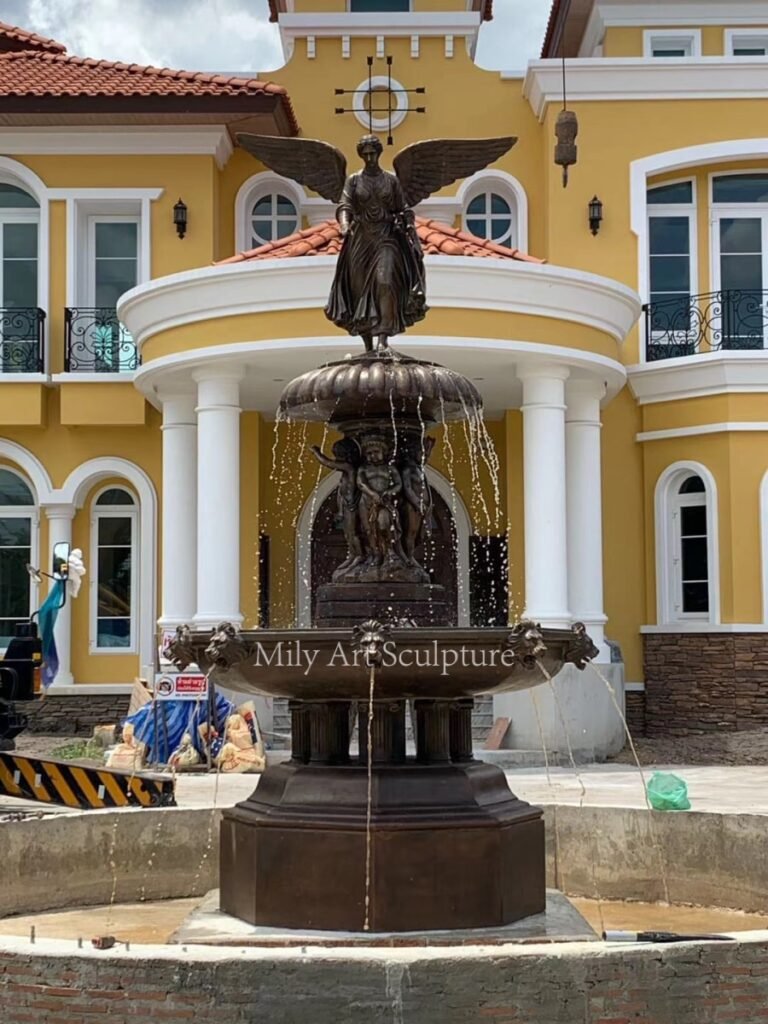
The Angel of the Waters stands as a testament to the technical excellence of 19th-century bronze casting. Standing 26 feet high atop a fountain that spans 96 feet in diameter, the sculpture demonstrates why bronze has been the preferred medium for public monuments throughout history.
The bronze material gives the angel a warm, golden-brown patina that has developed character over time. Bronze’s exceptional durability has allowed the sculpture to withstand New York’s variable climate for a century and a half with its details remaining crisp and defined.
The technical challenges of casting such a large and detailed figure were considerable. The angel’s flowing robes, delicate wings, and expressive face all required masterful modeling and casting techniques. The four smaller figures beneath the angel, representing Peace, Health, Purity, and Temperance, further showcase the versatility of bronze as an artistic medium.
As bronze foundry specialists, we particularly appreciate how the material’s properties have been leveraged in this sculpture. The metal’s ability to capture fine detail while maintaining structural integrity over generations makes it the perfect choice for such an important public artwork.
Symbolism and Meaning
The Angel of the Waters is rich with symbolism that connects biblical tradition with civic progress. The sculpture references the biblical Pool of Bethesda, where an angel would stir the waters, giving them healing properties. This biblical story provided a perfect metaphor for New York’s own healing waters from the Croton Aqueduct.
In the statue, the angel holds a lily in her hand, symbolizing purity—a direct reference to the clean water that transformed public health in the city. Her outstretched arm represents blessing, while her wings suggest divine intervention in human affairs.
The four smaller figures beneath the angel represent Peace, Health, Purity, and Temperance—virtues associated with clean water and public wellbeing. These allegorical figures reinforce the fountain’s message of healing and renewal.
When viewed as a whole, the bronze sculpture becomes more than just a beautiful object—it’s a powerful statement about the intersection of art, public health, and civic pride that continues to speak to visitors today.
Cultural Impact and Legacy
Since its unveiling in 1873, the Bethesda Fountain and its bronze angel have become one of New York’s most recognizable landmarks. The fountain has appeared in countless films, television shows, and photographs, cementing its place in popular culture.
Beyond its visual appeal, the fountain represents an important milestone in American art history as the first major public artwork created by a female sculptor in New York City. Emma Stebbins broke barriers for women artists, creating a masterpiece that has endured for generations.
The fountain continues to serve its original purpose as a gathering place at the heart of Central Park. On any given day, visitors from around the world congregate around the bronze angel, taking photos, enjoying the atmosphere, and perhaps reflecting on the sculpture’s message of healing and hope.
For bronze artists and foundries like ours, the Angel of the Waters remains an inspiration—a reminder of bronze’s enduring beauty and its power to communicate important ideas across generations.
Preservation and Restoration
Like all outdoor bronze sculptures, the Angel of the Waters requires careful maintenance to preserve its beauty and structural integrity. Over the years, the Central Park Conservancy has undertaken several restoration projects to ensure this bronze masterpiece continues to inspire future generations.
In the mid-1980s, the Conservancy funded a complete rebuilding of Bethesda Terrace. The fountain was thoroughly cleaned, repainted, and resealed with a protective coating in 1988. Today, bronze specialists wash and wax the fountain annually to protect it from environmental damage.
These preservation efforts highlight the importance of proper maintenance for bronze public art. While bronze is remarkably durable, regular care ensures that sculptures like the Angel of the Waters can continue to be enjoyed for centuries to come.
As a bronze foundry specializing in custom sculptures and reproductions, we understand the technical and artistic considerations that go into creating and maintaining such monumental works. The Angel of the Waters stands as a testament to bronze’s enduring legacy in public art.
Frequently Asked Questions About the Bethesda Fountain
1. What does the angel mean in the Bethesda Fountain?
The angel in the Bethesda Fountain, known as the “Angel of the Waters,” symbolizes healing and divine blessing. Created by sculptor Emma Stebbins, the angel represents the biblical story from the Gospel of John where an angel would stir the waters of the Pool of Bethesda in Jerusalem, bestowing healing powers to those who entered first. In the context of New York City, the angel also celebrates the 1842 completion of the Croton Aqueduct system, which brought fresh, clean water to the city and helped end the devastating cholera epidemics that had plagued New York. The lily in the angel’s hand represents purity, while her outstretched arm signifies blessing the water below.
2. What is the Bethesda Fountain famous for?
The Bethesda Fountain is famous for several remarkable distinctions. It stands as the only sculpture commissioned during the original design of Central Park and remains one of the largest fountains in New York City, measuring 26 feet high and 96 feet in diameter. The fountain is renowned for being the first major public artwork created by a female sculptor in New York City. Its iconic status has made it a beloved landmark that appears in countless films, television shows, and photographs. The fountain’s location at the heart of Central Park’s Bethesda Terrace creates one of the most picturesque and recognizable scenes in American public spaces, drawing millions of visitors annually who are captivated by its beauty and historical significance.
3. Who was the angel at the pool of Bethesda?
The angel at the pool of Bethesda refers to the biblical account in the Gospel of John (5:2-4), which describes an angel who would periodically stir the waters of the Pool of Bethesda in Jerusalem. According to the scripture, “whoever then first after the troubling of the waters stepped in was made whole of whatsoever disease he had.” This divine messenger was believed to impart healing properties to the water. While not named specifically in the Bible, this angel of healing became the inspiration for Emma Stebbins’ sculpture “Angel of the Waters,” which crowns the Bethesda Fountain in Central Park. The bronze figure represents divine intervention and the blessing of healing waters, connecting the biblical story to the modern fountain.
4. What is the meaning of the word Bethesda?
The word “Bethesda” comes from Aramaic and Hebrew origins, meaning “House of Mercy” or “House of Grace.” In biblical context, it referred to a pool in Jerusalem near the Sheep Gate, where the sick and disabled would gather hoping for healing. The name perfectly captures the essence of both the biblical location and the Central Park fountain, as both places are associated with healing, mercy, and restoration. When Emma Stebbins designed the Angel of the Waters for what would become known as the Bethesda Fountain, the name was chosen deliberately to evoke these themes of compassion and healing that were especially meaningful to New York City after its struggles with water-borne diseases.
5. What is the meaning of the Angel of the Waters?
The Angel of the Waters statue embodies multiple layers of meaning, both spiritual and civic. Created by Emma Stebbins between 1861 and 1868, the bronze figure celebrates the introduction of clean water to New York City through the Croton Aqueduct system, which Stebbins likened to the healing waters of the biblical Pool of Bethesda. The four smaller figures beneath the angel represent Peace, Health, Purity, and Temperance—virtues associated with clean water. On a personal level, the statue may have held special significance for Stebbins, as her own brother had died from cholera, a water-borne disease. As the first major public artwork created by a female sculptor in New York City, the Angel of the Waters also represents a breakthrough for women artists in America. Today, it stands as a symbol of healing, hope, and the triumph of public health initiatives in urban planning.
The Greatest Fountains in the World
| Fountain Name | Location | Notable Features | Historical Significance |
|---|---|---|---|
| The Fountain of Wealth | Singapore | Recognized as the world’s largest fountain by Guinness World Records (1998) | Based on Hindu Mandala design; represents wealth flowing inward according to feng shui |
| The Dubai Fountain | Dubai, UAE | Water jets reach up to 500 feet (152.4m); features daily light and music shows | Located on man-made Burj Khalifa Lake; designed by creators of the Bellagio Fountain |
| Jet d’Eau | Geneva, Switzerland | One of the tallest fountain sprays (460 feet/140m) | Operating since 1886; originally a safety release for a hydroelectric power grid |
| Trevi Fountain | Rome, Italy | Baroque masterpiece featuring Neptune and mythological figures | Completed in 1762; tradition of tossing coins ensures return to Rome |
| Bellagio Fountains | Las Vegas, USA | Choreographed water shows with music and lights | One of the most famous attractions on the Las Vegas Strip |
| King Fahd’s Fountain | Jeddah, Saudi Arabia | World’s tallest water fountain (850 feet/260m) | Also known as Jeddah Fountain; visible throughout the city |
| Moonlight Rainbow Fountain | Seoul, South Korea | Guinness World Record for longest bridge fountain (3,740 feet/1,140m) | Environmentally friendly design; spectacular night illumination |
| Bethesda Fountain | New York, USA | Features the “Angel of the Waters” bronze statue | First major public artwork by a female sculptor in NYC; symbolizes healing and hope |
| Buckingham Fountain | Chicago, USA | One of the world’s largest fountains in physical size | Built in 1927; features hourly water shows with lights and music |
| Magic Fountain of Montjuïc | Barcelona, Spain | Spectacular light, water and music performances | Built for the 1929 International Exhibition; restored for 1992 Olympics |
Creating Your Own Bronze Legacy
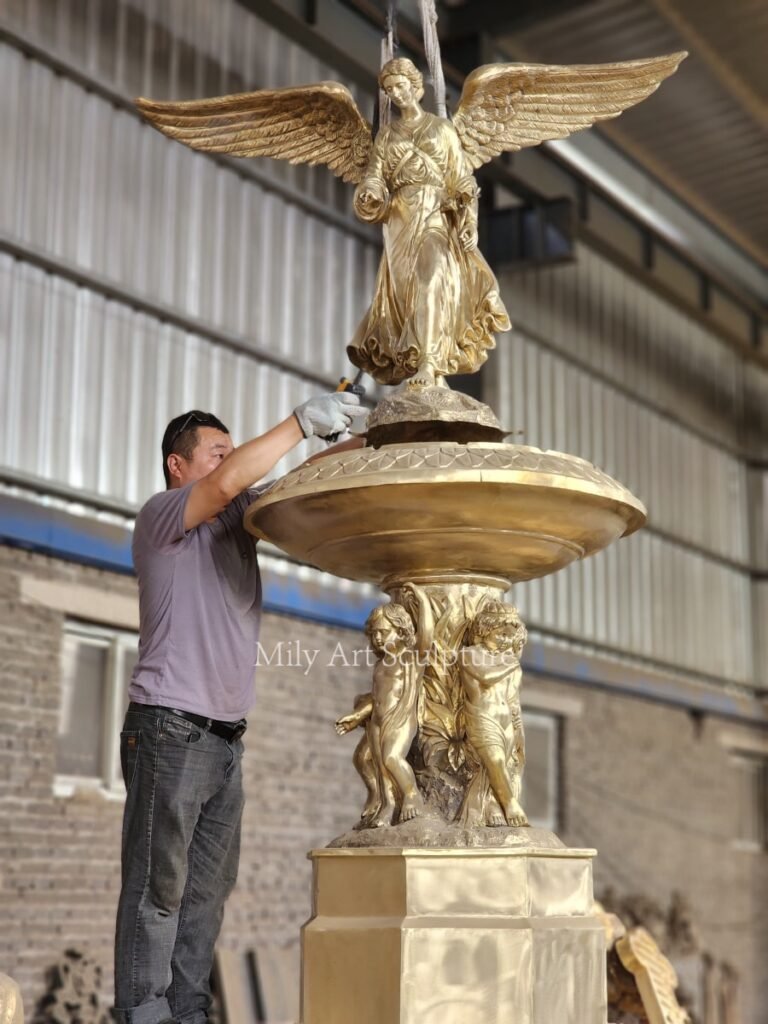
At Milystatue Bronze Foundry, we’re proud to continue the tradition of excellence in bronze casting that the Angel of the Waters exemplifies. Whether you’re interested in a custom sculpture, a reproduction of a classic work, or a commemorative piece, our skilled artisans bring the same attention to detail and commitment to quality that has made bronze the preferred medium for important artworks throughout history.
Bronze’s unique properties—its warmth, durability, and ability to capture fine detail—make it the perfect choice for creating pieces that will stand the test of time. Just as the Angel of the Waters has inspired visitors for 150 years, a bronze sculpture can become a lasting legacy for your home, garden, institution, or public space.
We invite you to explore the possibilities of bronze and to consider how this timeless material might help you create your own meaningful statement through art. Contact us today to discuss your vision for a custom bronze sculpture that captures the same timeless beauty and significance as the Angel of the Waters.


